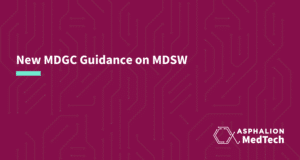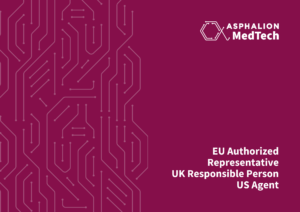
Increased complexity in the Medical Devices regulatory landscape is generating greater challenges that need to be addressed in order to maintain a competitive position in the market.
Asphalion’s solutions for Medical Devices cover a full range of technological segments, such as: Implants, Wound-care, Wearables, IVDs, Software as Medical Device, Substance based and Drug Device Combinations, among others.
Starting from a proof of concept, throughout the design & development process, product approvals and maintenance of the device in the market, Asphalion can provide you with full Regulatory and Quality Management System (QMS) support for a time to market optimisation by minimising regulatory setbacks since the very beginning.
MedTech Solutions
Our Medical Device services include:
The PRRC, or Person Responsible for Regulatory Compliance, is a new role introduced by the EU Medical Device Regulation (MDR) and In Vitro Diagnostic Medical Device Regulation (IVDR). The PRRC is responsible for ensuring that a medical device manufacturer complies with all applicable EU regulations. This includes ensuring that the manufacturer’s quality management system (QMS) is compliant, that the devices are designed and manufactured safely, and that they are properly marketed and post-market surveillance.
The PRRC must have the following qualifications:
The PRRC’s responsibilities include:
The PRRC can be an employee of the manufacturer or a third-party consultant. If the PRRC is a third-party consultant, the manufacturer must enter into a contract with the consultant that specifies the consultant’s responsibilities and liabilities.
The PRRC is an important new role under the EU MDR and IVDR. By ensuring that manufacturers comply with all applicable regulations, the PRRC helps to protect patients and ensure the safety of medical devices on the EU market.
If you are a medical device manufacturer, you need to ensure that you have a qualified PRRC in place. If you do not have the in-house resources to provide this function, you can outsource the PRRC service to a qualified consultancy firm.
At Asphalion we can help you with your PRRC needs. We have a team of experienced regulatory experts who can provide you with the support you need to comply with the EU MDR and IVDR. We can help you with all aspects of the PRRC process, from qualification and appointment to day-to-day support. We can also help you with other regulatory affairs matters, such as product registration, documentation preparation, and audit support.
As your trusted partner and EU Authorised Representative Asphalion will guide you to comply with European regulations for Medical Devices and IVD:
Why work with Asphalion?
As your UK Responsible Person we will not only assume the representative role with MHRA on your behalf, but also will provide you with:
With high knowledge and understanding of the EU and UK regulations and hence, their differences and synergies, we will assist you on establishing the best regulatory strategy considering the unique challenges and opportunities of the UK market.
The FDA requires that all foreign manufacturers have a US Agent to act as their official representative in the United States. At Asphalion, we offer comprehensive US Agent services for medical device manufacturers looking to expand their business in the US market.
As your US Agent, we provide:
Our team of regulatory affairs experts has extensive experience working with medical device manufacturers and navigating the complex regulatory landscape in the US. We are committed to providing our clients with the highest level of service and support to ensure compliance with all relevant regulations and requirements.
What are the benefits of working with a quality system under ISO 13485?
To whom does the ISO 13485 standard apply?
This standard applies to manufacturers, distributors, importers and Authorized representatives of medical devices, and also to sterilization services for medical devices and technical assistance and maintenance services.
Why is it necessary to carry out internal audits of the quality system under ISO 13485?
How the audit process is carried out:
What were the top 5 non-conformities as presented:
Number 1 – ISO 13485 Clause 7.1 – Planning of product realization including risk management
Key takeaway: Must ensure that you establish robust links to change management, PMS, and design inputs.
Number 2 – ISO 13485 Clause 8.2.4 – Internal audit
Key takeaway: Must ensure that you can show evidence of a risk-based approach to internal audits, covering regulatory requirements, by trained auditors, and with timely follow-up.
Number 3 – ISO 13485 Clause 7.5.6 – Validation of processes for production and service provision
Key takeaway: Must ensure that you can demonstrate robust process links to change and risk management processes.
Number 4 – ISO 13485 Clause 8.2.6 – Monitoring and measurement of product
Key takeaway: Must ensure that you have adequate monitoring and measuring for product conformity during manufacture and its conformity to design specification.
Number 5 – ISO 13485 Clause 7.5.1 – Control of production and service provision
Key takeaway: Must ensure that you can show sufficient control and records to demonstrate conformity to specification.
Reasons to outsource internal audits with Asphalion:
⬇️ Download here our Internal Audits flyer for more information
Introduction:
Detailed Overview of CER Structure
A Clinical Evaluation Report (CER) is fundamental to the MDR’s demand for detailed evidence of device efficacy and safety. Below is a comprehensive break-down of its typical structure:
Clinical Evaluation Routes and Device-Specific Considerations
Standards and Guidelines
Confronting Challenges and Outsourcing Rationale
Conclusion:
While MDR 2017/745 sets high standards for medical device regulation, a comprehensive understanding and application of the detailed structures and guidelines provided is crucial for achieving compliance.
Clinical evaluation, coupled with risk management, serves as the cornerstone of regulatory compliance for medical devices.
These elements are the focus of the most thorough scrutiny by notified bodies to ensure that devices meet relevant general safety and performance requirements before they reach the market.
Keeping abreast of these requirements and faithfully implementing them are key to successful device approval and continued market presence in the EU. By staying well-informed and vigilant in these areas, manufacturers can navigate the regulatory landscape more effectively and ensure ongoing compliance and safety of their products.
Schedule a free meeting!
Discuss your case with our experts and receive a valuable feedback
Downloads
Share
Why Asphalion MedTech?
With a strong track record of successfully executed projects for a wide range of products, including EU funded projects for development of highly complex and innovative technologies, Asphalion has gained key expertise in different technological areas and key regulatory areas.
In addition, Asphalion is strongly committed with digital transformation, which drives our team to provide expert support in development of digital solutions as medical devices. Furthermore, Asphalion is part of different MedTech clusters, which allows us to be at the forefront of digital innovation in the healthcare arena.
Main benefits

Related Resources

Advertising of medical devices (ES requirements)

New guidance

Additional National Procedures for Medical Devices in the Spanish Market

Navigate FDA Requirements with Confidence

Design and Development (D&D) for Medical Devices

Overview ofthe De Novo Pathway

Medical Device Software Standard IEC 62304:2006 /Amd 1:2015

Drug–device combination products (DDCs) and how are they classified in Europe

When manufacturers of medical devices operate outside certain regulatory regions, they must appoint an official representative to ensure compliance with local laws and regulations.

By prioritizing usability, devices achieve their intended purpose while protecting patients and users.

Risk Management for Medical Devices: Navigating ISO 14971:2019

The Medical Device Coordination Group (MDCG) has released the guidance document, MDCG 2025-5, “Questions & Answers regarding performance studies of in vitro diagnostic medical devices under regulation (EU) 2017/746,” dated June 2025.

The integration of artificial intelligence (AI) in medical technologies is rapidly reshaping the healthcare landscape. As AI becomes more embedded in medical and in vitro diagnostic devices, the need for
Services

By department
By stage of development
By product
By region
Other services
Schedule here a free 30-minutes meeting with one of our consultants and tell us about your project, challenges or doubts.
We will be happy to assist you!

| Cookie | Duration | Description |
|---|---|---|
| cookielawinfo-checkbox-advertisement | 1 year | Set by the GDPR Cookie Consent plugin, this cookie records the user consent for the cookies in the "Advertisement" category. |
| cookielawinfo-checkbox-analytics | 1 year | Set by the GDPR Cookie Consent plugin, this cookie records the user consent for the cookies in the "Analytics" category. |
| cookielawinfo-checkbox-necessary | 1 year | Set by the GDPR Cookie Consent plugin, this cookie records the user consent for the cookies in the "Necessary" category. |
| cookielawinfo-checkbox-others | 1 year | Set by the GDPR Cookie Consent plugin, this cookie stores user consent for cookies in the category "Others". |
| CookieLawInfoConsent | 1 year | CookieYes sets this cookie to record the default button state of the corresponding category and the status of CCPA. It works only in coordination with the primary cookie. |
| elementor | never | The website's WordPress theme uses this cookie. It allows the website owner to implement or change the website's content in real-time. |
| viewed_cookie_policy | 1 year | The GDPR Cookie Consent plugin sets the cookie to store whether or not the user has consented to use cookies. It does not store any personal data. |
| wpEmojiSettingsSupports | session | WordPress sets this cookie when a user interacts with emojis on a WordPress site. It helps determine if the user's browser can display emojis properly. |
| Cookie | Duration | Description |
|---|---|---|
| _ga | 1 year 1 month 4 days | Google Analytics sets this cookie to calculate visitor, session and campaign data and track site usage for the site's analytics report. The cookie stores information anonymously and assigns a randomly generated number to recognise unique visitors. |
| _ga_* | 1 year 1 month 4 days | Google Analytics sets this cookie to store and count page views. |
| _gat_gtag_UA_* | 1 minute | Google Analytics sets this cookie to store a unique user ID. |
| _gid | 1 day | Google Analytics sets this cookie to store information on how visitors use a website while also creating an analytics report of the website's performance. Some of the collected data includes the number of visitors, their source, and the pages they visit anonymously. |
| Cookie | Duration | Description |
|---|---|---|
| VISITOR_INFO1_LIVE | 6 months | YouTube sets this cookie to measure bandwidth, determining whether the user gets the new or old player interface. |
| VISITOR_PRIVACY_METADATA | 6 months | YouTube sets this cookie to store the user's cookie consent state for the current domain. |
| YSC | session | Youtube sets this cookie to track the views of embedded videos on Youtube pages. |
| yt-remote-connected-devices | never | YouTube sets this cookie to store the user's video preferences using embedded YouTube videos. |
| yt-remote-device-id | never | YouTube sets this cookie to store the user's video preferences using embedded YouTube videos. |
| yt.innertube::nextId | never | YouTube sets this cookie to register a unique ID to store data on what videos from YouTube the user has seen. |
| yt.innertube::requests | never | YouTube sets this cookie to register a unique ID to store data on what videos from YouTube the user has seen. |